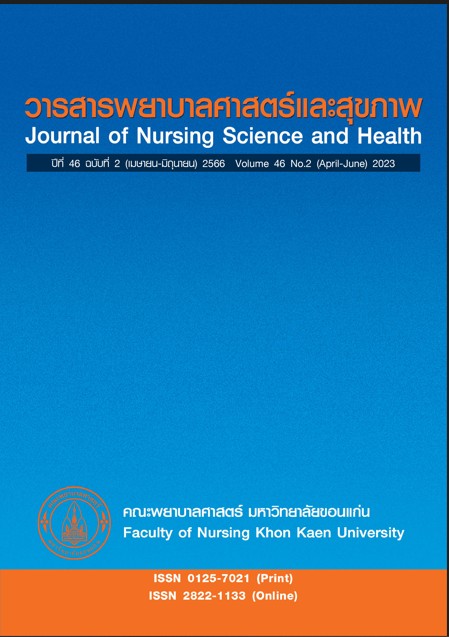การประยุกต์ใช้แบบแผนสุขภาพในการพยาบาลผู้ป่วยเด็กโรคมะเร็งกระดูกออสทีโอซาร์โคมา: กรณีศึกษา
คำสำคัญ:
แบบแผนสุขภาพ , การพยาบาลผู้ป่วยเด็ก , โรคมะเร็งกระดูกออสทีโอซาร์โคมา , กรณีศึกษาบทคัดย่อ
โรคมะเร็งกระดูกออสทีโอซาร์โคมาเป็นโรคที่พบมากในเด็กช่วงวัยรุ่นและทำให้มีอาการปวดกระดูก โรคนี้สามารถแพร่กระจายไปยังกระดูกส่วนอื่น เมื่อโรคแพร่กระจายเข้าสู่ปอดจะทำให้ผู้ป่วยเด็กเหล่านี้ส่วนมากเสียชีวิตได้ การรักษาใช้การผ่าตัด การฉายแสง หรือเคมีบำบัด หรือรักษาร่วมกัน อาจทำให้เกิดการสูญเสียแขนขาจากการรักษา ส่งผลต่อภาพลักษณ์ตามมา เกิดปัญหาต่อทั้งร่างกายและจิตใจ เพื่อลดความทุกข์ทรมานจากอาการของโรค และลดผลกระทบจากการรักษา พยาบาลจึงมีบทบาทสำคัญในการดูแลเด็กกลุ่มนี้เพื่อรักษาไว้ซึ่งโครงสร้างและหน้าที่ของร่างกาย ป้องกันภาวะแทรกซ้อน และส่งเสริมการฟื้นฟูสภาพของร่างกาย บทความนี้นำเสนอการพยาบาลผู้ป่วยเด็กโรคมะเร็งกระดูกออสทีโอซาร์โคมาโดยประยุกต์ใช้แนวคิด 11 แบบแผนของกอร์ดอน เนื้อหาประกอบด้วยโรคมะเร็งกระดูกออสทีโอซาร์โคมา แนวคิด 11 แบบแผนสุขภาพของกอร์ดอน แนวทางในการประยุกต์ใช้แบบแผนสุขภาพในการพยาบาลผู้ป่วยเด็กโรคมะเร็งกระดูกออสทีโอซาร์โคมา และกรณีศึกษา เพื่อให้พยาบาลสามารถประเมินภาวะสุขภาพของผู้ป่วยเด็กโรคมะเร็งกระดูกออสทีโอซาร์โคมา และให้การพยาบาลอย่างเหมาะสม ส่งผลให้ผู้ป่วยและผู้ดูแลมีคุณภาพชีวิตที่ดี
เอกสารอ้างอิง
Suri M, Soni N, Okpaleke N, Yadav S, Shah S, Iqbal Z, et al. A deep dive into the newest avenues of immunotherapy for pediatric osteosarcoma: A systematic review. Cureus 2021;13:e18349.
Belayneh R, Fourman MS, Bhogal S, Weiss KR. Update on osteosarcoma. Curr Oncol Rep 2021;23:71.
Hutspardol S. Cancer in children. In: Chansakulporn S, Treesirichod A, luevisadpaibul C, Prommalikit O, Assadamongkol K, Chongbanyatcharoen P, editors. Pediatrics. Vol 2. 2nd ed. Bangkok: Noppachai Printing; 2014. p. 736–81. (in Thai)
Xin S, Wei G. Prognostic factors in osteosarcoma: A study level meta-analysis and systematic review of current practice. J Bone Oncol 2020;21:100281.
Monsereenusorn C. Common solid tumors. In: Torcharus K, Staworn D, Sirithangul S, Gengsakul A, editors. Textbook of pediatrics. Bangkok: Phramongkutklao College of Medicine; 2014. p. 561-82. (in Thai)
Lissauer T, Carroll W, Craft A, editors. Illustrated textbook of paediatrics. 5th ed. [n.p.]: Elsevier; 2018.
Wannasuntad S, Petchpichetchian W. Nurse’s role and ethical issues related to cancer care in children. Journal of Boromarajonani College of Nursing, Bangkok 2013;29(1):158-68. (in Thai)
McKinney ES, James SR, Murray SS, Nelson KA, Ashwill JW. Maternal-child nursing. 5th ed. St. Louis, Missouri: Elsevier; 2018.
Jafari F, Javdansirat S, Sanaie S, Naseri A, Shamekh A, Rostamzadeh D, et al. Osteosarcoma: A comprehensive review of management and treatment strategies. Ann Diagn Pathol 2020;49:151654.
Stuck S. Hematolotic, immunologic, and neoplastic disorders. In: Rudd K, Kocisko DM, editors. Pediatric nursing: The critical components of nursing care. Philadelphia: F.A. Davis; 2014. p.427-47.
Zhao X, Wu Q, Gong X, Liu J, Ma Y. Osteosarcoma: A review of current and future therapeutic approaches. Biomed Eng Online 2021; 20:1-14.
Argenziano M, Tortora C, Pota E, Di Paola A, Di Martino M, Di Leva C, et al. Osteosarcoma in children: Not only chemotherapy. Pharmaceuticals 2021;14:923.
Papakonstantinou E, Stamatopoulos A, I Athanasiadis D, Kenanidis E, Potoupnis M, Haidich AB, et al. Limb-salvage surgery offers better five-year survival rate than amputation in patients with limb osteosarcoma treated with neoadjuvant chemotherapy. A systematic review and meta-analysis. J Bone Oncol 2020; 25:100319.
Altay N, Kilicarslan-Toruner E, Sari Ç. The effect of drawing and writing technique on the anxiety level of children undergoing cancer treatment. European Journal of Oncology Nursing: The Official Journal of European Oncology Nursing Society 2017;28:1–6.
Wiwatkamonchai A, Kantawang S, Mesukk J. Chronic Sorrow and Management Strategies Among Parents of Children with Cancer Receiving Chemotherapy. Nursing Journal 2017;44(1):62-73. (in Thai)
Punthase P. Nursing process & functional health pattern: application in clinical practice. 18th ed. Bangkok: Pimasksorn; 2009. (in Thai)
Siripul P. Symptom management: Nursing care for pediatric patients with leukemia. Khon Kaen: Faculty of Nursing, Khon Kaen University; 2011. (in Thai)
Ruktrirong J, Traivaree C, Monsereenusorn C, Photia A, Lertvivatpong N, Rujkijyanont P. Single daily dosing versus divided dosing intravenous ondansetron to prevent chemotherapy-induced nausea and vomiting among children: A comparative randomized double-blind controlled trial. Pediatr Blood Cancer 2021;68:e29002.
Kitchen B. Renal disorders. In: Rudd K, Kocisko DM, editors. Pediatric nursing: The critical components of nursing care. Philadelphia: F.A. Davis; 2014. p.351-70.
ดาวน์โหลด
เผยแพร่แล้ว
รูปแบบการอ้างอิง
ฉบับ
ประเภทบทความ
สัญญาอนุญาต
ลิขสิทธิ์ (c) 2023 วารสารพยาบาลศาสตร์และสุขภาพ

อนุญาตภายใต้เงื่อนไข Creative Commons Attribution-NonCommercial-NoDerivatives 4.0 International License.
วารสารพยาบาลศาสตร์และสุขภาพเป็นเจ้าของลิขสิทธิ์ในการเผยแพร่ผลงานที่ตีพิมพ์ห้ามผู้ใดนำบทความที่ได้รับการตีพิมพ์ในวารสารพยาบาลศาสตร์และสุขภาพไปเผยแพร่ในลักษณะต่าง ๆ ดังนี้ การนำบทความไปเผยแพร่ออนไลน์ การถ่ายเอกสารบทความเพื่อกิจกรรมที่ไม่ใช่การเรียนการสอน การส่งบทความไปตีพิมพ์เผยแพร่ที่อื่น ยกเว้นเสียแต่ได้รับอนุญาตจากวารสารพยาบาลศาสตร์และสุขภาพ



